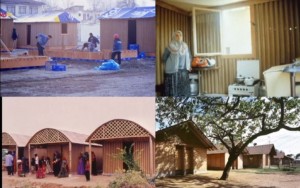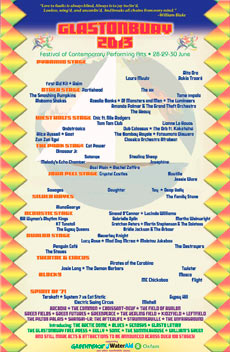Gasland, the Fracking Truth
It’s amazing that what took mother nature millions of years to buid can be destroyed in a few hours with heavy machinery” – Josh Fox
Gasland: The Movie
“The largest domestic natural gas drilling boom in history has swept across the United States. The Halliburton-developed drilling technology of “fracking” or hydraulic fracturing has unlocked a “Saudia Arabia of natural gas” just beneath us.
When filmmaker Josh Fox is asked to lease his land for drilling, he embarks on a cross-country odyssey uncovering a trail of secrets, lies and contamination. A recently drilled nearby Pennsylvania town reports that residents are able to light their drinking water on fire. This is just one of the many absurd and astonishing revelations of a new country called GASLAND. Part verite travelogue, part expose, part mystery, part bluegrass banjo meltdown, part showdown.”
Gasland- Reviews (at bottom of page)
The Oil Industry has tried to discredit the film and the issues it raises via a disinformation campaign, including a video in direct response to the film .
Gasland replied to its accusations in detail on its website.
Green MP Caroline Lucas Arrested in Fracking Protest
Why would Green Party Member of Parliament be willing to face arrest in order to demonstrate against the process of fracking in the UK?
Caroline Lucas, the MP for Brighton Pavilion said:
“Along with everyone else who took action today, I’m trying to stop a process which could cause enormous damage for decades to come. People today, myself included, took peaceful non-violent direct action only after exhausting every other means of protest available to us.
Despite the opposition to fracking being abundantly clear, the government has completely ignored the views of those they are supposed to represent. When the democratic deficit is so enormous, people are left with very little option but to take peaceful, non-violent direct action.”
The Department o Energy and Climate Change did not respond to requests for comment on the protests.
When one reads documentation concerning the effects of Fracking and the Oil Industry on human health and the environment, it becomes very clear why this issue is one worth protesting about.
THE ENDOCRINE DISRUPTION EXCHANGE
“To date, no chemical in use has been thoroughly tested for its endocrine disrupting effects. Traditional toxicological testing protocols were not designed to test for endocrine disruption and to test at ambient or low exposure levels.”
The Endocrine Disruption Exchange is one of the few organisations that has studied the effects of products and chemicals used in the Oil/Gas industry.
Its findings are very disturbing.
Extract:
T he technology to recover natural gas depends on undisclosed types and amounts of toxic chemicals.
A list of 944 products containing 632 chemicals used during natural gas operations was compiled. Literature searches were conducted to determine potential health effects of the 353 chemicals identified by Chemical Abstract Service (CAS) numbers.
-
More than 75% of the chemicals could affect the skin, eyes, and other sensory organs, and the respiratory and gastrointestinal systems.
-
Approximately 40-50% could affect the brain/nervous system, immune and cardiovascular systems, and the kidneys;
-
37% could affect the endocrine system; and
-
25% could cause cancer and mutations.
-
These results indicate that many chemicals used during the fracturing and drilling stages of gas operations may have long-term health effects that are not immediately expressed.
- In addition, an example was provided of waste evaporation pit residuals that contained numerous chemicals on the Comprehensive Environmental Response, Compensation, and Liability Act (CERCLA) and Emergency Planning and Community Right to Know Act (EPCRA) lists of hazardous substances.
- The discussion highlights the difficulty of developing effective water quality monitoring programs.
- To protect public health we recommend full disclosure of the contents of all products, extensive air and water monitoring, coordinated environmental/human health studies, and regulation of fracturing under the U.S. Safe Drinking Water Act.
Extracting, processing, and burning fossil fuels (natural gas, oil and coal) introduces huge volumes of harmful chemicals into our environment. These chemicals, and the tens of thousands of chemical products synthesized from them, are now present in every environment on earth, including the womb. Extremely low concentrations of many chemicals can damage the endocrine system of our bodies by interfering with the intricate, delicate network of natural chemical interactions critical to healthy development and normal function.
n 1991, an international group of experts stated, with confidence, that “Unless the environmental load of synthetic hormone disruptors is abated and controlled, large scale dysfunction at the population level is possible.”
They could not perceive that within only ten years, a pandemic of endocrine-driven disorders would begin to emerge and increase rapidly across the northern hemisphere. Today, less than two decades later, hardly a family has not been touched by Attention Deficit Hyperactivity Disorder, autism, intelligence and behavioral problems, diabetes, obesity, childhood, pubertal and adult cancers, abnormal genitalia, infertility, Parkinson’s or Alzheimer’s Diseases.
TEDX’s findings confirm that each of these disorders could in part be the result of prenatal exposure to chemicals called endocrine disruptors. TEDX has also confirmed that the feed stocks for most endocrine disrupting chemicals are derived from the production of coal, oil, and natural gas. It is clear that endocrine disruption, like climate change, is a spin-off of society’s addiction to fossil fuels. Setting aside the effects of endocrine disruptors on infertility, and just considering their influence on intelligence and behavior alone, it is possible that hormone disruption could pose a more imminent threat to humankind than climate change
Fracking and Hazardous Waste
Many people and animals have fallen ill since fracking started in their area. The process of fracking pumps toxic chemicals at high pressure into the earth in order to cause minor earthquakes that loosen deposits of natural gas that have been trapped in the rock for millions of years. The process threatens to pollute groundwater and an estimated 30% to 70% of poisoned water is estimated to resurface and continue to surface for the life of the well (20 – 30 years)
Why is this Allowed?
Many of the chemicals used in the process of fracking are considered hazardous waste.
Why are these toxins being allowed to be pumped into the earth all over the USA when they are a real danger to drinking water supplies?
“In his second week in office, George W. Bush created the energy task force, officially known as the
National Energy Policy Development Group, with Vice President Dick Cheney as chairman. In
its mission, NEPDG aimed to: “develop a national energy policy designed to help the private
sector. . . .”
Only when pressed by EPA chief Christie Todd Whitman did Cheney remove a recommendation to
exempt fracturing from the task force’s final report. Whereupon, the Bush/Cheney Energy Bill of
2003 included a provision to exempt fracturing from EPA drinking water regulation — but Congress
removed the provision from the final draft.
Whereupon, in the Energy Policy Act of 2005, Congressmen James Inhofe of Oklahoma and Joe
Barton of Texas inserted language to:
“Amend the Safe Drinking Water Act of 1996 to exempt
hydraulic fracturing related to oil and gas production . . . and, thus, exclude this practice from . . .
regulations related to the protection of underground sources of drinking water.”
– Steve Coffman (on Gasland’s official reply to the Gas Industry’s attempt to discredit the film.)
BBC Horizon Documentary on Fracking
The BBC Program: Horizon made a documentary examining the process of Fracking which questions whether there were indeed (as the Oil/Gas companies would have us believe) no risks involved to people living near the the Fracking wells.
Communities did appear to be experiencing high levels of illness. It seemed strange that so little was understood about the causes of the illnesses. One factor may have been that many people had received compensation and had signed gagging clauses which did not allow them to discuss their situation.
Plenty of people did seem willing to talk about afflictions to themselves and animals in the area that appeared since fracking began.
The reason for lack of clarity about the cause became apparent when the rights of industry to avoid transparency was raised.
Money is More Important than the Health of USA Citizens.
Drilling companies in the USA are allowed to keep the chemicals used in their procedures a secret, even when they may be causing a health risk. This makes it almost impossible for people to know what might have be causing the illnesses that have occurred since the fracking began in their areas.
Medical doctors have managed to get special permission to be request this information from the companies.
Doctors Can’t Tell Their Patients
One doctor has treated people with leisions to their faces that she thinks might be related to chemicals from fracking . The drilling companies only allow her access to the information about chemicals they use, under the strictest of conditions. They insist the doctors sign a confidentiality statement which means they are unable to tell their patients what they have discovered are causing their illnesses.
If a doctor (that has been given the information about the chemicals) has now been able to diagnose the cause of the medical problem decides they need to refer the patient to another medical specialist, they are not allowed to pass on the information to the other doctor or medical specialist.
“for physicians in order to take care of your patients, there needs to be transparency and this completely breaks that down, so yes it’s very upsetting for us because we want people to get better, but if you can’t explain to someone what’s happening to them, how do you get them better… and then how do you find out if other members of their family may have been exposed .. or other people in the area may have been exposed because no one can talk about it. So it really goes against any type of modern medicine“
Reviews of Gasland
Robert Koehler of Variety referred to it as “one of the most effective and expressive environmental films of recent years… Gasland may become to the dangers of natural gas drilling what Silent Spring was to DDT.”[18]
Eric Kohn of IndieWire wrote, “Gasland is the paragon of first person activist filmmaking done right… By grounding a massive environmental issue in its personal ramifications, Fox turns Gasland into a remarkably urgent diary of national concerns.”[19]
Stewart Nusbaumer of the Huffington Post wrote “Gasland… just might take you from outrage right into the fire of action.”[20]
Gasland currently holds a 97% rating on the film site Rotten Tomatoes based on 37 reviews.[21] Mark Kermode of BBC Radio 5 Live gave it a generally positive review, criticizing its similarity to other recent oil documentaries, yet praising its “extraordinary visual kick”. He said “it is a very interesting story which is made better by the fact that the visuals of it are very poetic, very lyrical”, and felt that its themes and ideas were relevant and well presented.
The Denton Record Chronicle said “Fox decides that his own backyard in Pennsylvania isn’t his exclusive property… Set to his own banjo music and clever footage, Gasland is both sad and scary… if your soul isn’t moved by the documentary, yours is a heart of shale.”[22]
Bloomberg News critic Dave Shiflett wrote that Fox “may go down in history as the Paul Revere of fracking.”[23]
Chicago TimeOut gave Gasland four out of five stars.[24]
In Australia, film critic Julie Riggs called the documentary a “horror movie, and a wake-up call.”[25][26]
Fort Worth Business Press writer John-Laurent Tronche talks about the growing number of documentaries “that aim to shed a light on what they call a dirty, destructive practice: shale gas exploration. And although oil and gas supporters have labeled the motion pictures as radical propaganda, a local drilling activist said they’re part of a larger, critical look into an ever-growing industry.”[27]
Read MoreShigeru Ban: Revolutionary Humanitarian Environmentally Friendly Architecture
 Shigeru Ban is an accomplished international architect with an interest in humanitarianism and sustainability. He is best known for his innovative work with paper, particularly recycled cardboard tubes which have been used in many countries to house disaster victims quickly and efficiently.
Shigeru Ban is an accomplished international architect with an interest in humanitarianism and sustainability. He is best known for his innovative work with paper, particularly recycled cardboard tubes which have been used in many countries to house disaster victims quickly and efficiently.
Born in Tokyo, Japan in 1957 he studied architecture in the USA and was particularly inspired by time spent studying under John Hejeduk, the most experimentally minded of the New York Five from whom he developed an interest in ‘architectonic poetics’ or the creation of three-dimensional poetry.
An important theme in his work is “invisible structure” which incorporates the structural elements as integral parts of the design.
As a Japanese architect he uses many traditional themes and methods such as shōji and the idea of a ‘universal floor’ to allow continuity between all rooms in a house. He was also one of the first Japanese architects to embrace a combination of Japanese and Western styles.
Architects, as he says in this video, traditionally work for people with money and power but he wanted to build useful structures for everyday people.
Shigeru was working on ecological and environmentally friendly ways of building long before environmental awareness became mainstream. His explorations in the use of different building materials led to much work with paper and cardboard as the basic building material. His interest in paper stems from its sustainability as a low cost, low tech, recyclable and replaceable material.
He was surprised to discover that paper was in fact far stronger than he had expected, as well as being easy to use and easy to fireproof. With these qualities in mind he developed ways to use it as a medium for creating buildings for people in disaster areas and has used it successfully in many countries and continents.
In times of disaster, building materials are limited and prices for obtaining them rise. Developing a method for building with cardboard tubing has made it far easier to source materials.
During the Rwanda crisis, the UN provided the refugees with aluminium tubing as frames for building shelters, to try and stop the deforestation that was occurring with people cutting down trees to build with.
The refugees ended up selling the aluminium for money and then reverted to cutting down trees.
Paper tubing is cheap and more versatile than tents and the community can participate in constructing their own shelters.
Shigeru often gets local students to participate in projects and help with the construction of buildings in disaster areas. For one of their buildings he chose to use beer crates as the foundation layer. The crates were donated by a Japanese beer company and Shigeru and the students thought of sending a complaint to the donor company, he says with a twinkle in his eye, when they discovered to their disappointment that the beer crates arrived empty, rather than with itinerant containers of beer intact.
In the video he talks of the various types of buildings he has designed including many refugee shelters as well as some of the churches he has built to replace those destroyed in natural disasters.
Read MoreMandela Day: You are The Power of Change
Mandela Day is an international day in honour of Nelson Mandela,
celebrated annually on the 18th of July – Mandela’s Birthday.
It is a call to action for individuals – for people everywhere –
to take responsibility for changing the world into a better place,
one small step at a time, just as Mr Mandela did.
Following the success of Nelson Mandela’s 90th birthday celebrations in London’s Hyde Park in June 2008 and the 4664 concerts, it was decided that there could be nothing more fitting than to celebrate Mr Mandela’s birthday each year with a day dedicated to his life’s work and that of his charitable organisations, and to ensure his legacy continues forever.
The day was officially declared by the United Nations in November 2009. Mandela Day is not meant as a public holiday but is a global call to action that celebrates the idea that each individual has the ability to make an impact and the power to transform the world.
The Mandela Day campaign message is simple: Mr Mandela gave 67 years of his life fighting for the rights of humanity. All we are asking is that everyone gives 67 minutes of their time, whether it’s supporting your chosen charity or serving your local community.
Long Road to Freedom
On August 5th, 1962, an ordinary piece of road along the R103 about 3 kilometres outside Howick in KwaZulu-Natal took on extraordinary significance when armed apartheid police flagged down a car.
The man pretending to be the chauffeur had earned the nickname of the “Black Pimpernel” having evaded capture by the apartheid regime for 17 months. It was in this dramatic manner at this unassuming place that Nelson Mandela was finally captured and was to disappear from public view for the next 27 years.
Mandela had just paid a clandestine visit to ANC President Chief Albert Luthuli to report on his African Odyssey. His meeting was also to request support for an armed struggle, after having spent most of his adult life trying to find peaceful ways in which to end the injustice and suffering caused by the system of Apartheid in South Africa, without success.
50 years later on August 4th 2012, to mark the anniversary of the start of Nelson Mandela’s “long walk to freedom” a quietly powerful new sculpture was inaugurated and unveiled at this spot.
The sculpture is comprised of 50 steel column constructions, each between 6.5 and 9.5 meters tall, set into the landscape of the Natal Midlands. The posts are staggered and the portrait of Nelson Mandela only comes into correct focus when the posts line up at a position 35 meters from the sculpture (a reference to the fact that Mandela proved notoriously difficult for the authorities to find).
From this perspective the sculpture reads as a familiar photograph of Mandela, suggestive of his incarceration as one is aware it is comprised essentially of a series of steel bars, but seen from other angles the design splinters into a dynamic moment of fracture and release.
The artist Marco Cianfanelli comments on the deliberate structural paradox, that, “this represents the momentum gained in the struggle through the symbolic of Mandela’s capture. The 50 columns represent the 50 years since his capture, but they also suggest the idea of many making the whole; of solidarity. It points to an irony as the political act of Mandela’s incarceration cemented his status as an icon of struggle, which helped ferment the groundswell of resistance, solidarity and uprising, bringing about political change and democracy”.
http://www.mandela-children.org.uk/
Read MoreRolling Stones Headline at Glastonbury
home to Glastonbury Abbey, one of the most important abbeys in England.
It’s also a town which attracts thousands of people interested in New Age or Pagan beliefs largely because of the myths and legends related to Glastonbury Tor.
These include references to the Holy Grail, King Arthur and Joseph of Arimathea, with some Arthurian literature identifying it as the legendary Island of Avalon.
Glastonbury Festival of Contemporary Performing Arts
Internationally Glastonbury is best known as home to the most famous music festival in the world – The Glastonbury Festival of Contemporary Performing Arts which includes dance, comedy, theatre, circus, cabaret and other arts as well as contemporary music.
Festival organiser Michael Eavis is a local farmer who was inspired after seeing the open air Led Zeppelin concert at Bath Festival of Blues and Progressive Music, 1970 to host an open air festival on the the farm. 14 people invested everything they had to build the stage (many told them the idea would never catch on). The first festival was in 1970 – and the rest as they say, is history.
Rolling Stones Live at Glastonbury 2013
The Rolling Stones headlined the Pyramid Stage, playing to a crowd of over 170,000 (not bad for a group that has been around for 50 years).
Their gig started around 9.45 pm at the end of a beautifully sunny day in Somerset with the crowd waiting in electric anticipation for the most high profile act ever to perform at Glastonbury (having taken 43 years to get there) .
The Stones played a twenty song set including a version of “Factory Girl” which with specially adapted lyrics became “Glastonbury Girl”
“It was one of the greatest rock and roll sets I’ve ever seen in my life and I think one of the greatest rock and roll sets Glastonbury has ever seen”. “They really just rocked it. The band seemed almost as impressed as the crowd. I guess the audience makes the gig as much as the band.” Telegraph music critic Neil McCormick
Rolling Stones Glastonbury Song List:
‘Jumpin’ Jack Flash’
‘It’s Only Rock ‘N Roll (But I Like It)’
‘Paint It, Black’
‘Gimme Shelter’
‘Glastonbury Girl’
‘Wild Horses’
‘Doom And Gloom’
‘Can’t You Hear Me Knocking’
‘Honky Tonk Women’
‘You Got The Silver’ ‘Happy’
‘Miss You’
‘Midnight Rambler’
‘2000 Light Years From Home’
‘Sympathy For The Devil’
‘Start Me Up’
‘Tumbling Dice’
‘Brown Sugar’
‘You Can’t Always Get What You Want’ ‘
(I Can’t Get No) Satisfaction’
What the Posters Say
An interesting article by musician and writer, Anya Pearson looks at festivals as an annual yardstick of Britain’s musical talent. By taking the much publicised Festival Posters and editing out all acts represented on the posters that do not include at least one female musician, she turns them into a barometer of gender equality in 21st Century Britain. “As a female musician currently in two mixed-gender bands, I have always been painfully aware of my minority status in the music scene.” she says.
Glastonbury 2013 Poster showing music acts appearing at the festival

Glastonbury 2013 Poster – showing only acts that include
at least one female musician (34%).

Glastonbury was not the worst offender for failing to represent female musicians, probably thanks partly to co-organiser of the event, Emily Eavis, but its poster still only had 34% of the acts that included female musicians.
Bestival 2013 Poster showing music acts appearing at the festival

Bestival 2013 Poster showing only acts that include
at least one female (21%)

Reading and Leeds 2013: Poster showing music acts appearing at the festivals

Reading and Leeds 2013: Poster showing only music acts appearing at
the festivals which include at least one female (17%)

Pearson concludes:
“Still, festivals alone are not to blame: promoters, managers and record labels all play their part. As a society we are less encouraging of girls who aspire to headline Glastonbury. I was lucky. My mother is a musician who started out in the 70s and always told me my XX chromosome was no barrier to making music.
That said, there are lots of brilliant female musicians out there – as Yoko Ono’s Meltdown at the Southbank Centre proved. Women aren’t passive consumers of popular culture – we just often lack a creative platform to showcase what we can do.”
http://www.glastonburyfestivals.co.uk/
http://womensliberationmusicarchive.co.uk/
http://www.southbankcentre.co.uk/whatson/festivals-series/yoko-onos-meltdown/
http://www.guardian.co.uk/commentisfree/2013/jun/26/glastonbury-festival-few-women-artists
Read MoreFiddle Oak: Welcome to my World
The profoundest thought or passion
sleeps as in a mine,
until an equal mind and heart
finds and publishes it.
— Ralph Waldo Emerson —
Have you ever looked at a beautiful lichen covered rock with wild-flowers dropping pollen on it, and wished you could find a landscape as lovely to step into?
With a bit of imagination you can, as
Fiddle Oak demonstrates in his photograph: “The Melody”
Inspiration may come on a calm evening spent sharing
Summer Tales with a friend:
.. Or even arrive with tomorrow’s dinner.
Fiddle Oak: Travels with Betsy and Diana
This magical journey is brought to you by a 14 year old photographer who lives in a suburb of Boston and is home-schooled by his mother who is a sculptor.
Zev Hoover was eight when he started taking photos on his mobile phone for fun. His mother saw the potential he was showing and bought a point and shoot camera for him on eBay. It wasn’t long before she bought him a better one. And then an even better one.
He now has two cameras, both which he has named. He calls his still camera “Betsy” and his video camera is “Diana”.
“I like naming things,” he says. “My bike is named Patrick.”
The youngest in a family, with four siblings ,he gives his older sister Nell credit for helping with some of the ideas for the images he creates. She suggested the idea of images of little folk and he came up with the name of Fiddle Oak as his Flickr name, a play on the words.
“My sister is more of a writer, but she is sort of my partner in crime,” he says. “I do the actual work with the camera and edit the picture, but she helps with a lot of the concepts.”
He describes the process of creating the images:
“I shoot what I call the background — the scene, without props, first. Often it’s a collage of multiple pictures. Then I try to match the lighting of that picture and take pictures of people in the right position to be in the pictures, then I shrink them in Photoshop and change the colors so they match the background a little bit better, then I do overall color editing to make them match. It takes a long time.”
Thanks to Sail for sharing this story .
Read More
Earth Day 2013 – Share Your Photos
Earth Day 2013: The Face of Climate Change
Climate change has many faces.
A man in the Maldives worried about relocating his family as sea levels rise, a farmer in Kansas struggling to make ends meet as prolonged drought ravages the crops, a fisherman on the Niger River whose nets often come up empty, a child in New Jersey who lost her home to a super-storm, a woman in Bangladesh who can’t get fresh water due to more frequent flooding and cyclones…
And they’re not only human faces.
They’re the polar bear in the melting arctic, the tiger in India’s threatened mangrove forests, the right whale in plankton-poor parts of the warming North Atlantic, the orangutan in Indonesian forests segmented by more frequent bushfires and droughts…
These faces of climate change are multiplying every day.
For many, climate change can often seem remote and hazy – a vague and complex problem far off in the distance that our grandchildren may have to solve. But that’s only because they’re still fortunate enough to be insulated from its mounting consequences. Climate change has very real effects on people, animals, and the ecosystems and natural resources on which we all depend. Left unchecked, they’ll spread like wildfire. 
Luckily, other faces of climate change are also multiplying every day.
Every person who does his or her part to fix the problem is also a Face of Climate Change: the entrepreneurs who see opportunity in creating the new green economy, the activists who organize community action and awareness campaigns, the engineers who design the clean technology of the future, the public servants who fight for climate change laws and for mitigation efforts, the ordinary people who commit to living sustainably…
Between now and Earth Day, we’ll collect and display images of people, animals, and places directly affected or threatened by climate change – as well as images of people stepping up to do something about it. We’ll tell the world their stories.
But we need your help. We need you to be climate reporters. So, send us your pictures and stories that show The Face of Climate Change.
On and around Earth Day, an interactive digital display of all the images will be shown at thousands of events around the world, including next to federal government buildings in countries that produce the most carbon pollution. The display will also be made available online to anyone who wants to view or show it. Together, we’ll highlight the solutions and showcase the collective power of individuals taking action across the world. In doing so, we hope to inspire our leaders to act and inspire ourselves to redouble our efforts in the fight against climate change.
http://www.earthday.org/2013/about.html
Read More







